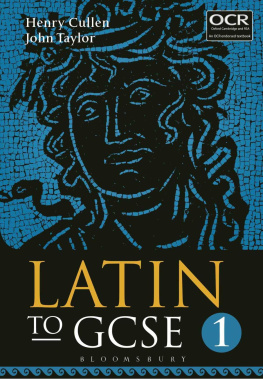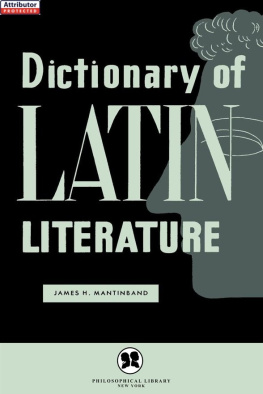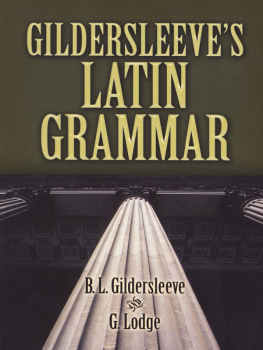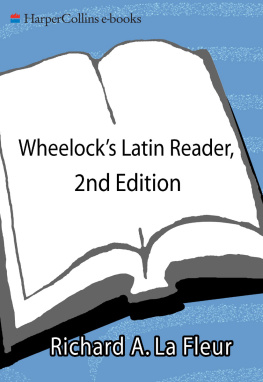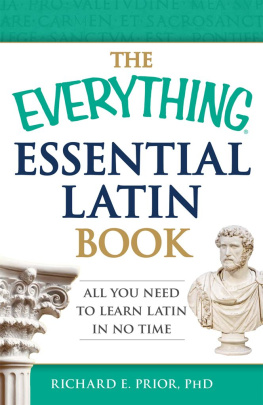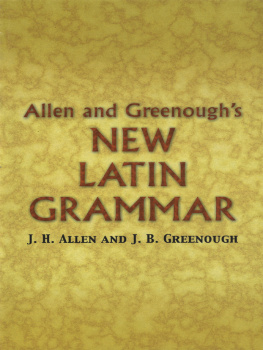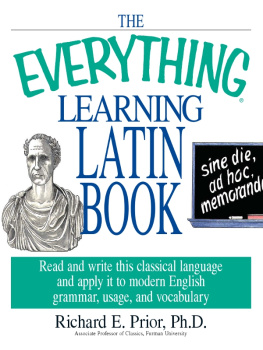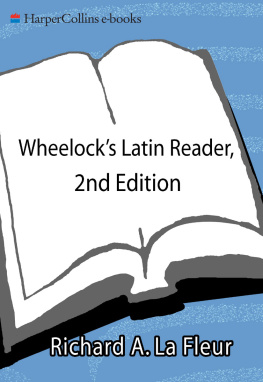ALSO AVAILABLE FROM BLOOMSBURY
Essential GCSE Latin, John Taylor
Greek to GCSE: Part 1, John Taylor
Greek to GCSE: Part 2, John Taylor
Greek Beyond GCSE, John Taylor
Latin Beyond GCSE, John Taylor
Latin Language Tests for Levels 1, 2 and GCSE, Ashley Carter
Latin Momentum Tests for GCSE, Ashley Carter
Latin Stories: A GCSE Reader, Henry Cullen, Michael Dormandy and John Taylor
Latin to GCSE: Part 2, Henry Cullen and John Taylor
Supplementary resources for Latin to GCSE: Parts 1 and 2 can be found at
www.bloomsbury.com/Cullen-Taylor-Latin-to-GCSE
Please type the URL into your web browser and follow the instructions to access the Companion Website. If you experience any problems, please contact Bloomsbury at academicwebsite@bloomsbury.com
This resource is endorsed by OCR for use with specification OCR GCSE (9-1) Latin (J282). In order to gain OCR endorsement, this resource has undergone an independent quality check. Any references to assessment and/or assessment preparation are the publishers interpretation of the specification requirements and are not endorsed by OCR. OCR recommends that a range of teaching and learning resources are used in preparing learners for assessment. OCR has not paid for the production of this resource, nor does OCR receive any royalties from its sale. For more information about the endorsement process, please visit the OCR website, www.ocr.org.uk.

CONTENTS
The authors have become increasingly aware of the need for a new Latin textbook that takes students efficiently from scratch to GCSE, enabling them to begin reading Latin as quickly as possible but without compromising on the fundamentals of grammar. Many existing textbooks are excessively long and unwieldy, or pay insufficient attention to grammar, or both. Others not aimed specifically at GCSE introduce material that many students and teachers do not have time to cover. Many teachers share these frustrations; we hope that this course provides a useful new option.
Latin to GCSE aims to be both traditional and up-to-date. We do not apologise for the fact that it takes grammar seriously: grammatical understanding is essential for both progress in and enjoyment of Latin. It cannot simply be glossed over; nor (regrettably) is it something that students absorb by osmosis. At the same time, the needs of todays students are borne constantly in mind. We have tried to focus on things that students find difficult and that often cause mistakes at GCSE; we concentrate on the understanding of principles, in both accidence and syntax, so that the need for rote learning is reduced. The stories have been selected both for the intrinsic interest of their subject matter and for their importance in the Roman history: amongst them are many old favourites, which students of Latin should not reach GCSE without having covered.
We should like to thank Deborah Blake for the initial invitation to write the book, and Alice Wright, Commissioning Editor for Classical Studies and Archaeology at Bloomsbury, for her constant help and encouragement, and not least her patience. The boys of Tonbridge School proved willing guinea-pigs for several early drafts of Part 1, and our former colleagues there offered valuable feedback at several stages. We are particularly grateful to Chris Burnand and Katy Waterfield who commented in detail on a penultimate version of the text, to its considerable advantage. We also wish to thank the several anonymous readers provided by Bloomsbury. The practice papers in Chapter 12, in the style of the new GCSE (9-1) for examination in 2018 onwards, have been adapted from recent past papers by kind permission of OCR. The book is directed primarily at the OCR GCSE, but we hope it may also be useful to pupils studying for the WJEC examination, and more broadly to learners of Latin of any age.
Henry Cullen would like in addition to thank Ed and Patte Sullivan. It was his tutoring of them that provided the initial inspiration for this project; revising the final sections of Part 1 at their home in Portland, Oregon, in August 2015 made for satisfying ring composition.
We have read and commented on successive drafts of each others work, but Henry Cullen remains responsible for Part 1 and John Taylor for Part 2.
An answer key and other supplementary resources are available at www.bloomsbury.com/Cullen-Taylor-Latin-to-GCSE
Henry Cullen
John Taylor
October 2015
The chapter vocabularies for Part 1 and Part 2 cover the GCSE Defined Vocabulary List. In passages, GCSE words are underlined and glossed in blue when they first occur. The underlining is repeated for words that recur in the same passage: they should then be learned. They can be checked in the chapter vocabularies, or in the Latin-English vocabulary in the back of the book.
Non-GCSE words are underlined and glossed, again with the underlining repeated. Proper names are normally underlined and glossed at their first occurrence in a passage, but the underlining is not repeated.
In the glossed vocabulary underneath a passage, nouns are given with genitive singular and gender. 2-1-2 adjectives are given with feminine and neuter endings. Third declension adjectives are given with the neuter nominative singular if (like for tristis) it is different from the masculine/feminine, or with the genitive singular if (like for ingens) the neuter nominative singular is the same as the masculine/feminine. Verbs are given with principal parts (present tense, infinitive, perfect tense) to the extent that those principal parts are required to translate the form that appears in the passage.
| e.g. | puella -ae f | girl |
| laetus -a -um | happy |
| tristis -e | sad |
| ingens -entis | huge |
| porto -are -avi | I carry |
English to Latin sentences are included throughout the book to provide practice in working that way round (once more an option at GCSE) and because the authors think that translating into Latin is invaluable for consolidating the language.
The requirements of the English to Latin section of the GCSE are explained after Chapter Six on pages 21215; here you will find exam-style practice sentences.
Given the limited range of the vocabulary and syntax required for this section of the exam, many of the English to Latin exercises in this book go well beyond what candidates might find on an actual GCSE paper (they use, for example, wider vocabulary or more complex accidence and syntax). Where this is the case you will see the Stretch & Challenge (S&C) sign. Sometimes this sign appears part way through an exercise; this indicates that the sentences from that point onwards go beyond the requirements of the English to Latin section of the exam. We hope that students will not be deterred from attempting those sections marked S&C.
| abl | ablative |
| acc | accusative |
| adj | adjective |
| adv | adverb |
| conj | conjunction |
| dat | dative |
| f | feminine |
| fut | future |
| gen | genitive |
| imperat | imperative |
| indecl | indeclinable (does not change its endings) |
| inf | infinitive |
| irreg |
Next page
